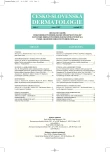Pseudoporphyria
Authors:
L. Malina
Authors‘ workplace:
Dermatovenerologická klinika 1. LF UK a VFN
přednosta prof. MUDr. J. Štork, CSc.
Published in:
Čes-slov Derm, 82, 2007, No. 1, p. 12-15
Category:
Reviews (Continuing Medical Education)
Overview
Pseudoporphyria is a phototoxic dermatitis clinically and histologically closely resembling porphyria cutanea tarda (PCT), but without enhanced urinary and faecal excretion of higher-carboxylic porphyrins. Photosensitivity is basically caused by natural or arteficial UVA- or visible radiation. The disease is induced either by metabolic factor (higher plasma concentration of porphyrins in patients with chronic renal failure on hemodialysis) or by different drugs and their components (frequently by NSAIDs), by cosmetic products, suntan lotions, long-acting ingredients of nutrition products, and by hormones. Also immunity pattern of the patient may play a role in its origin. As far as therapy of pseudoporphyria is concerned, only elimination of noxious influence of known photosensibilizing drugs and of the exposure to the radiation of the above spectral regions leads to healing of skin changes.
Key words:
pseudoporphyria – porphyria – PCT – phototoxicity – photosensitizing drugs – photodermatoses – solaria – PUVA
Labels
Dermatology & STDs Paediatric dermatology & STDsArticle was published in
Czech-Slovak Dermatology

2007 Issue 1
Most read in this issue
- The Desmoid Tumor – A Locally Aggressive Neoplasm
- Psychodermatology and Psychosomatic Approach Psycho-neuro-endocrino-immuno-dermatology
- Pseudoporphyria
- Group Approach Psychotherapy on Patients with Psoriasis
